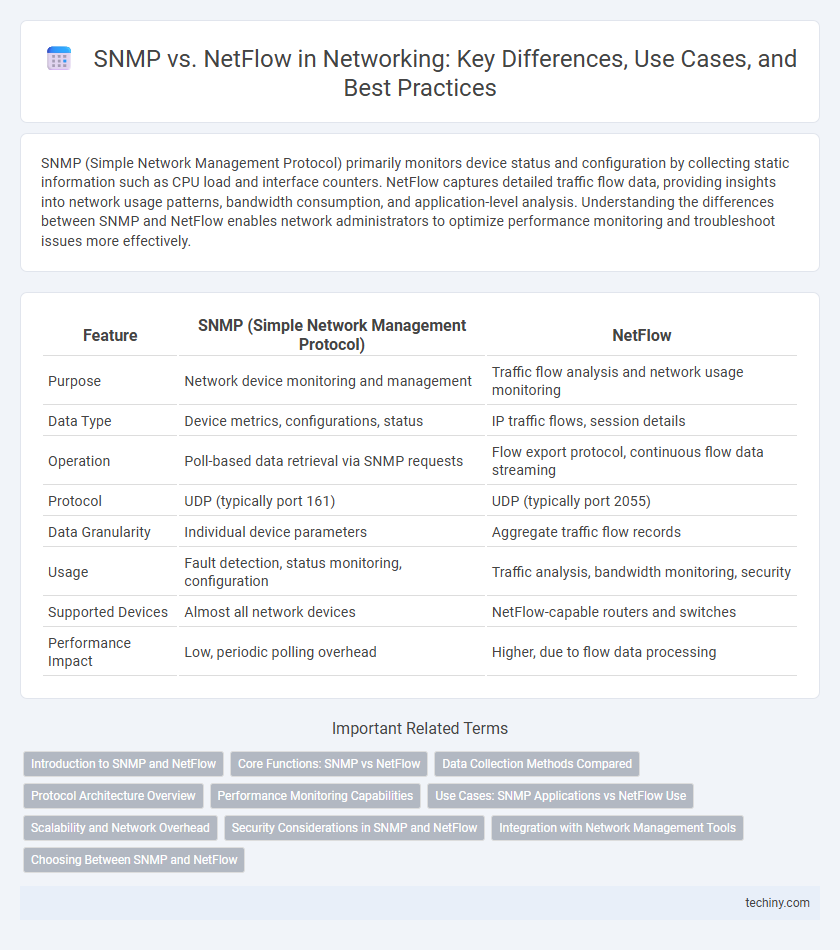SNMP (Simple Network Management Protocol) primarily monitors device status and configuration by collecting static information such as CPU load and interface counters. NetFlow captures detailed traffic flow data, providing insights into network usage patterns, bandwidth consumption, and application-level analysis. Understanding the differences between SNMP and NetFlow enables network administrators to optimize performance monitoring and troubleshoot issues more effectively.
Table of Comparison
| Feature | SNMP (Simple Network Management Protocol) | NetFlow |
|---|---|---|
| Purpose | Network device monitoring and management | Traffic flow analysis and network usage monitoring |
| Data Type | Device metrics, configurations, status | IP traffic flows, session details |
| Operation | Poll-based data retrieval via SNMP requests | Flow export protocol, continuous flow data streaming |
| Protocol | UDP (typically port 161) | UDP (typically port 2055) |
| Data Granularity | Individual device parameters | Aggregate traffic flow records |
| Usage | Fault detection, status monitoring, configuration | Traffic analysis, bandwidth monitoring, security |
| Supported Devices | Almost all network devices | NetFlow-capable routers and switches |
| Performance Impact | Low, periodic polling overhead | Higher, due to flow data processing |
Introduction to SNMP and NetFlow
SNMP (Simple Network Management Protocol) is a widely used protocol for monitoring and managing network devices by collecting device status and performance data through polling and traps. NetFlow is a network protocol developed by Cisco that captures detailed IP traffic flow information, enabling granular analysis of bandwidth usage and network behavior. Both SNMP and NetFlow provide critical data for network administrators, with SNMP focusing on device management and health metrics, while NetFlow emphasizes traffic patterns and flow monitoring.
Core Functions: SNMP vs NetFlow
SNMP (Simple Network Management Protocol) primarily monitors and manages network devices by collecting real-time device status, configuration, and performance metrics through polling and traps. NetFlow focuses on capturing detailed IP traffic flow data, offering insights into bandwidth usage, traffic patterns, and network behavior at the packet level. SNMP excels in device health monitoring, while NetFlow provides comprehensive network traffic analysis for capacity planning and security monitoring.
Data Collection Methods Compared
SNMP collects network performance data by querying device counters and interface statistics at regular intervals, providing a snapshot of network status. NetFlow captures detailed flow-level data by monitoring IP traffic in real time, allowing analysis of communication patterns and bandwidth usage. SNMP offers device-level metrics, while NetFlow delivers granular visibility into actual traffic flows across the network.
Protocol Architecture Overview
SNMP (Simple Network Management Protocol) operates on an agent-manager model, enabling real-time monitoring and management of network devices using standardized MIBs (Management Information Bases). NetFlow, developed by Cisco, functions as a flow-based protocol aggregating and exporting IP traffic data to collectors for detailed network traffic analysis. While SNMP focuses on device status and configuration via polling, NetFlow emphasizes flow-level data collection, providing granular insights into traffic patterns and bandwidth usage.
Performance Monitoring Capabilities
SNMP provides device-level performance monitoring by querying metrics such as CPU usage, memory, and interface statistics through polling. NetFlow captures detailed traffic flow data, enabling deep visibility into bandwidth utilization, application performance, and network bottlenecks. Combining SNMP's system metrics with NetFlow's flow analysis offers comprehensive performance monitoring for proactive network management.
Use Cases: SNMP Applications vs NetFlow Use
SNMP is primarily used for monitoring and managing network devices by collecting device status, configuration, and performance metrics through standardized MIBs. NetFlow excels in analyzing network traffic flows, providing detailed insights into bandwidth usage, traffic patterns, and security threats for congestion management and anomaly detection. Enterprises deploy SNMP for real-time device health checks and configuration management, while NetFlow is favored for traffic analysis, capacity planning, and detecting Distributed Denial of Service (DDoS) attacks.
Scalability and Network Overhead
SNMP offers scalability by enabling centralized management of numerous network devices with minimal configuration, but its polling mechanism can introduce significant network overhead in large infrastructures. NetFlow provides detailed traffic analysis with lower overhead by exporting flow records asynchronously, making it more efficient for high-scale environments. For extensive networks requiring granular traffic insight, NetFlow's reduced polling load enhances scalability while minimizing bandwidth consumption compared to SNMP.
Security Considerations in SNMP and NetFlow
SNMP security relies heavily on version 3, which supports authentication and encryption, mitigating risks such as unauthorized access and data interception inherent in earlier versions. NetFlow, while primarily designed for traffic monitoring and analysis, can expose sensitive information if flow data is not properly secured or encrypted during transmission. Implementing strong access controls, encryption protocols, and consistent monitoring are critical to safeguarding network data in both SNMP and NetFlow environments.
Integration with Network Management Tools
SNMP provides real-time device status and performance metrics through standardized MIBs, enabling seamless integration with most network management frameworks like Cisco Prime and SolarWinds. NetFlow captures detailed traffic flow data, offering granular insights into bandwidth usage and application performance, which tools such as PRTG and ManageEngine effectively leverage. Combining SNMP and NetFlow enhances overall network visibility, facilitating comprehensive monitoring and proactive issue resolution within enterprise environments.
Choosing Between SNMP and NetFlow
Choosing between SNMP and NetFlow depends on the network monitoring requirements; SNMP excels in device status, configuration management, and threshold-based alerts by polling network routers and switches. NetFlow provides detailed traffic analysis, including source and destination IPs, protocols, and flow volumes, making it ideal for bandwidth monitoring and security anomaly detection. For comprehensive network visibility, combining SNMP's device-level metrics with NetFlow's flow-based traffic insights delivers optimal performance and fault management.
SNMP vs NetFlow Infographic

 techiny.com
techiny.com